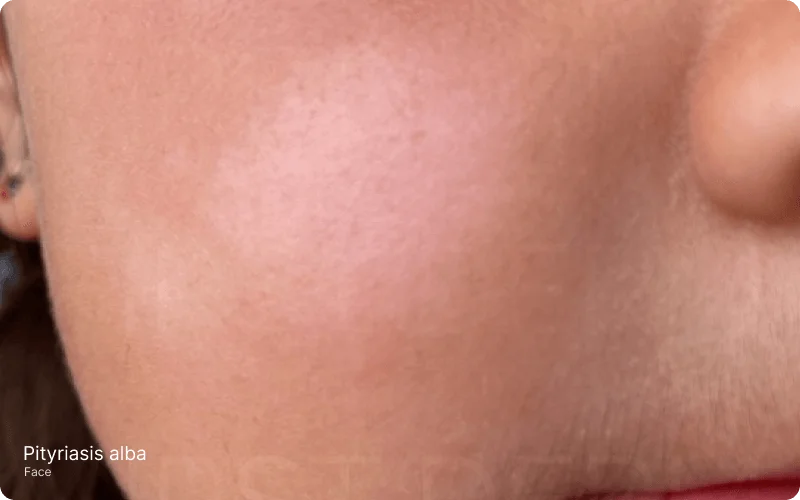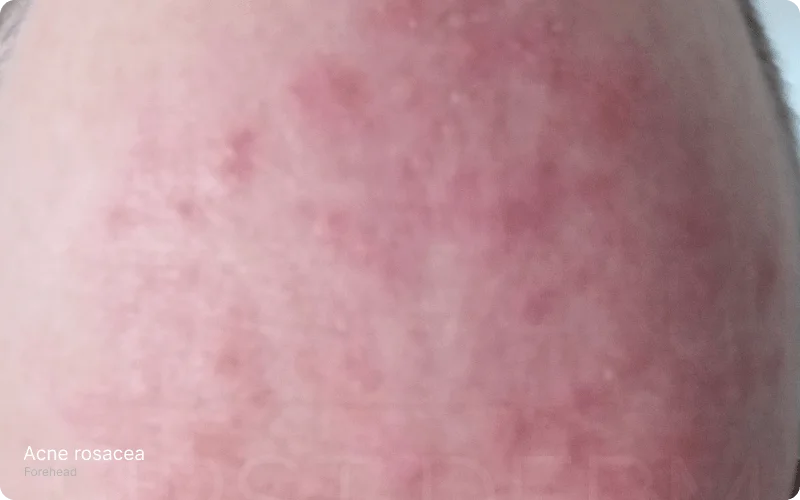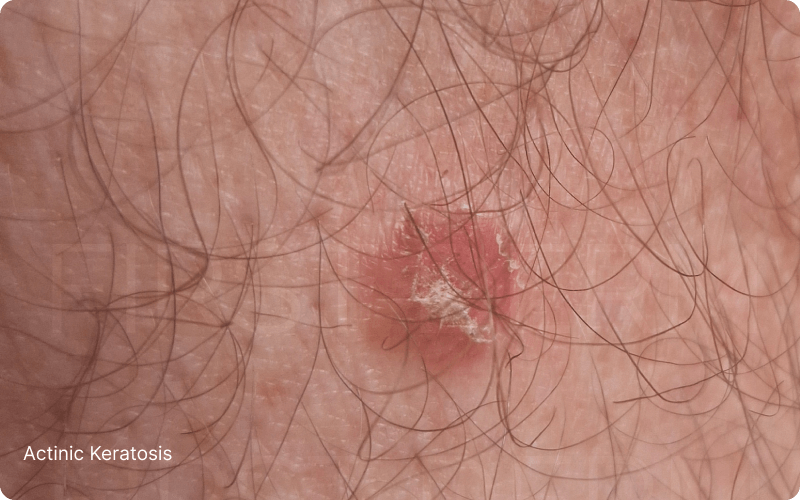Non-Itchy Skin: From Flat Spots to Raised Bumps

Despite safe sex practices and condom use, the World Health Organization estimates that almost one million new instances of sexually transmitted diseases (STDs) are acquired every day. The good news is that many of these situations are simple to diagnose and cure. Because periodic STD testing helps to avoid the inadvertent transmission of STDs, it’s critical to be tested regularly. Early STD screening not only protects your relationships. Regardless of sexual orientation or sexual history, all sexually active persons require STD testing. However, there isn’t just one sort of STD test. The test may be a swab, a urine sample, or a blood test, depending on the disease being tested.
A rash is an inflammation of the skin that causes a change in texture or color. It might be localized or widespread on your skin, depending on the reason. You may feel itchy or irritated, and your skin may be scaly, discolored, uncomfortable, dry, or even have sores. However, you may occasionally see a non-itchy rash. Rashes are typically caused by an allergic response to particular foods or substances. Though this rash is not very dangerous in and of itself, knowing what caused it might help you manage it better and prevent it from developing.
Common Non-Itchy, STD-Related Skin Conditions
Syphilis and Skin Symptoms
- Rough red or reddish brown rash on the palms and soles of the foot
- Lymph nodes swollen
- Fever
- Throat discomfort
- Hair loss in patches
- Headaches and muscle pains
- Fatigue (extreme weariness)
- Even if you don’t get treated, these symptoms will go away. However, if you are not treated, your infection will worsen.
Genital Warts (HPV)
At some time in their life, nearly all sexually active persons will get infected with at least one form of human papillomavirus (HPV), the virus that causes genital warts.
The signs and symptoms of genital warts include:
- Small, flesh-colored, brown or pink swellings in your genital area
- A cauliflower-like shape caused by several warts close together
- Itching or discomfort in your genital area
- Bleeding with intercourse
Molluscum Contagiosum
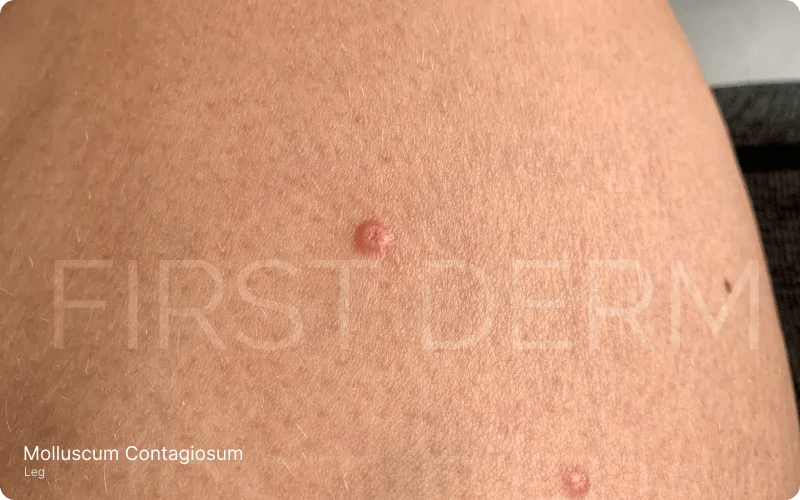
Close-up of non-itchy skin bumps on a thigh, indicative of Molluscum Contagiosum, a benign but contagious condition caused by a poxvirus
Molluscum contagiosum is a poxvirus infection caused by the molluscum contagiosum virus. The infection normally causes a benign, minor skin illness with lesions (growths) that can arise anywhere on the body. The virus that causes molluscum spreads from direct person-to-person physical contact and through contaminated fomites.
Among the indications and symptoms of Molluscum contagiosum are:
- pimples that are raised, spherical, and skin-colored
- Small bumps, often less than 1/4 inch (less than 6 millimeters) in diameter
- Bumps with a little ding or dot at the center at the top
- Pink pimples that itch
Herpes (HSV)
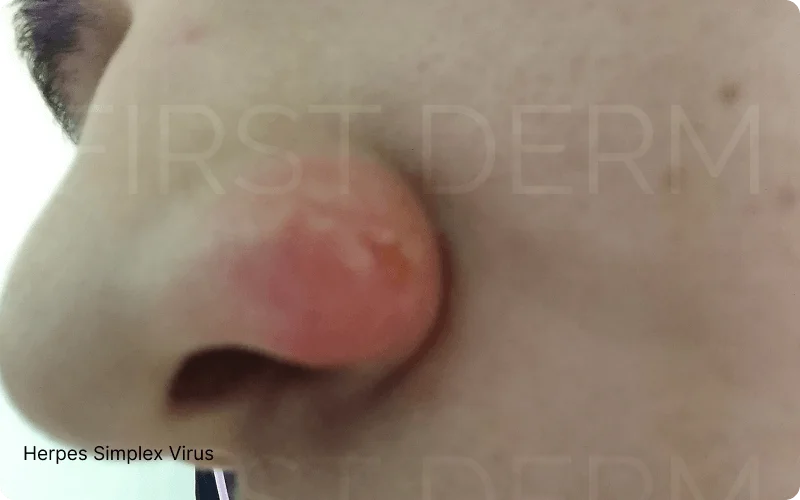
Herpes Simplex infection manifesting as non-itchy skin bumps on the nose, surrounded by red inflamed skin.
Blisters or ulcers can be unpleasant and reoccurring.
Blisters (cold sores) or open sores (ulcers) in or around the mouth or lips are common oral herpes symptoms caused by HSV1.
Bumps, blisters, or open sores (ulcers) around the genitals or anus are common genital herpes symptoms caused by HSV 2. These blisters and sores are usually painful. Blisters may rupture, leak, and crust over.
HIV – Early Skin Manifestations
Skin problems are frequent among HIV/AIDS patients. Germs that take advantage of a compromised immune system cause diseases, including Kaposi sarcoma, thrush, and herpes. That is why they are referred to as “opportunistic” infections.
Others, such as photodermatitis, may be caused by a hyperactive immune system that reactivates during antiretroviral medication therapy or by the medicines themselves.
Prurigo nodularis is more frequent in patients with severely compromised immune systems, as well as in people of color living with HIV/AIDS. To treat the condition, topical steroid therapy (lotions or creams applied directly to the skin) and HIV/AIDS management with antiretroviral medicines are employed.
Non-STD Skin Conditions Lacking the Itch Factor
Birthmarks
A birthmark is any mark that is present on the skin at birth or develops soon after. The cause of a birthmark is usually unknown. They are not created by a mistake made by the mother during pregnancy. They occur by chance.
There are various types of birthmarks including:
- Naevus flammeus, also known as a stork bite or stork mark
- Mongolian spots
- Haemangioma of infancy, also known as a strawberry mark or strawberry naevus
- Café au lait spots
- Congenital melanocytic naevus.
Age spots
Age spots are tiny, flat regions of dark skin on the skin. They vary in size and are most commonly found on sun-exposed regions such as the face, hands, shoulders, and arms.
Hyperactive pigment cells generate age spots. UV radiation accelerates the formation of melanin, a natural pigment that gives skin its color.
Age spots appearance:
Are there flat, oval patches of enhanced pigmentation?
Are typically tan to dark brown in color.
Melasma
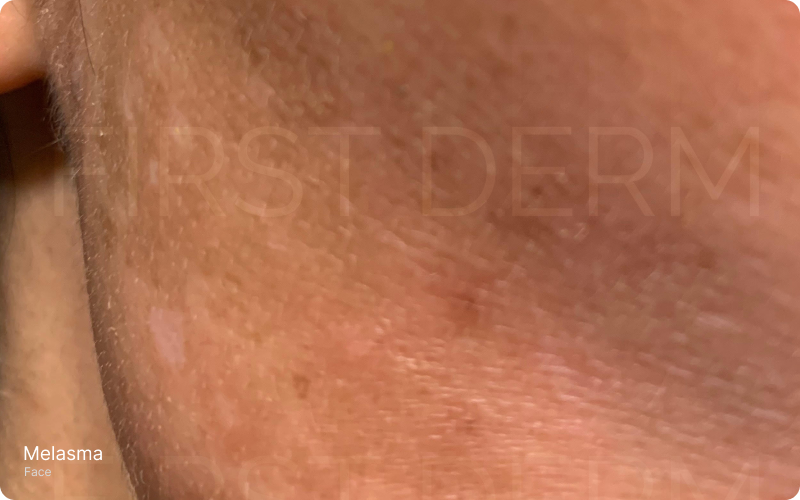
face displaying brown and blue-gray patches indicative of Melasma, a non-itchy skin condition often influenced by sun exposure and hormones
Melasma is a skin ailment that appears as brown or blue-gray patches or freckle-like spots on the skin. It’s commonly referred to as the “mask of pregnancy.” Melasma is caused by an overproduction of the cells that give your skin its color. It occurs due to the increased production of melanin hormone.
Vitiligo
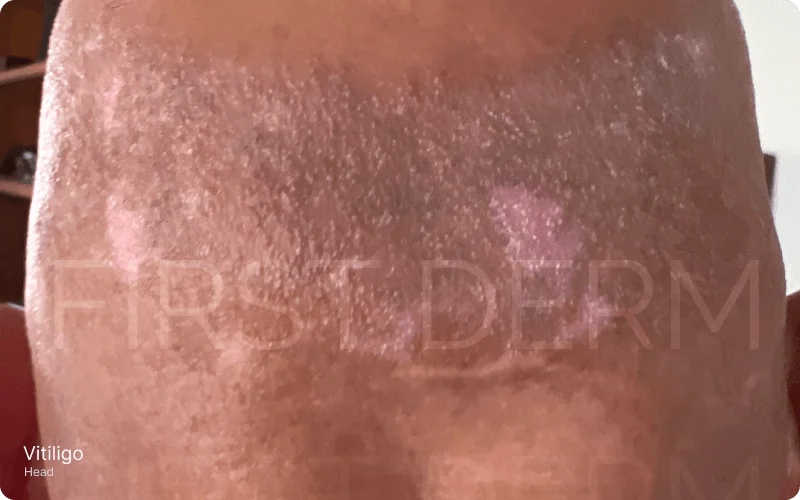
Close-up of the back of the head featuring patches of depigmented skin, indicative of Vitiligo, a non-itchy autoimmune condition that impacts melanocytes, causing loss of skin color.
Vitiligo is a chronic autoimmune skin condition that causes regions of the skin to lose functioning melanocytes. Multiple combinatorial variables contribute to disease progression, with immunological T cytotoxic cells playing an important role.
Raised But Not Irritated: Types of Non-Itchy Skin Lesions
Skin Tags

Close-up of a skin-colored, non-itchy raised bump behind the ear on the neck, identified as a skin tag. Common in adults and often related to weight gain or diabetes, these harmless lesions can appear in skin folds.
These lesions commonly appear in skin folds, such as the axilla, neck, eyelids, and groin. Skin-colored, brown, or even red ovoid growths that are typically pedunculated and linked to a fleshy stalk are the lesions.
Moles
The quantity and appearance of moles might alter. Some go away with time, frequently without your knowledge. They also adapt to hormonal changes, such as during pregnancy, when they may become somewhat darker.
Cherry angiomas
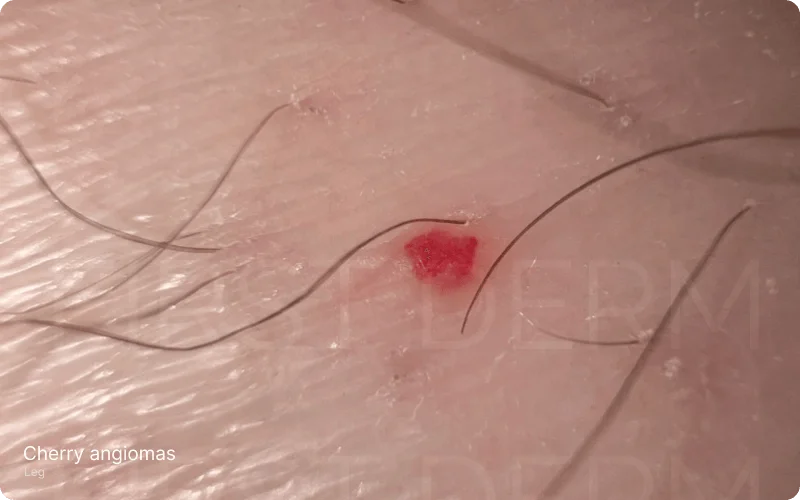
A bright red, non-itchy raised bump on the leg, identified as a cherry angioma. These common skin growths range from a pinpoint to one-fourth of an inch in diameter and are caused by a collection of small blood vessels.
Cherry angiomas are little, pinhead-like lesions on your skin that most typically form on your torso, arms, and legs. Cherry angiomas are also known as:
- Round.
- Size fluctuates between 2 to 4 millimeters (mm).
- Red ranging from light to dark.
Keratin accumulation
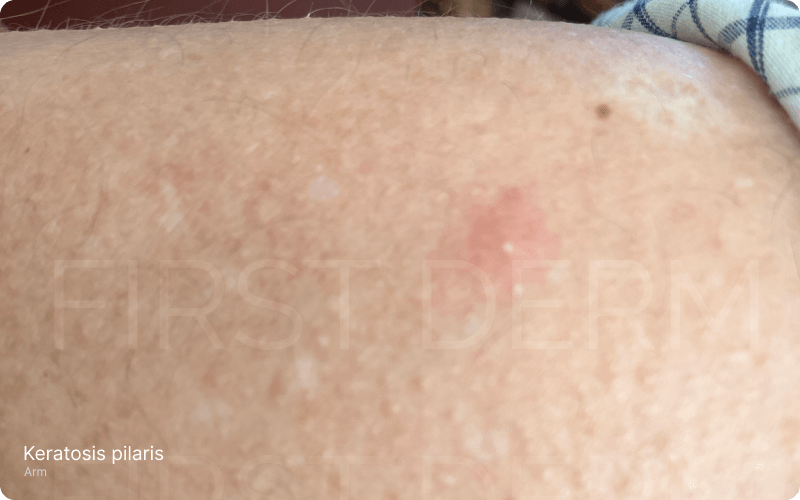
Close-up of the upper arm showing small, rough, non-itchy raised bumps, characteristic of Keratosis Pilaris. This common, benign skin condition is caused by extra keratin production, affecting skin texture.
Keratin accumulation causes keratosis pilaris, which is a hard protein that defends the skin from dangerous chemicals and infection.
It is a skin disorder that creates dry, rough patches and small bumps on the upper arms, thighs, cheeks, and buttocks. The pimples seldom pain or itch.
Lipomas
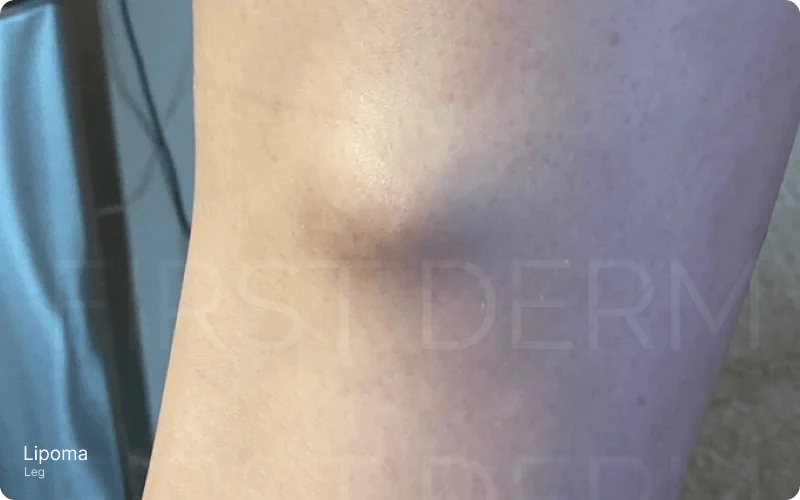
Soft, rounded, non-itchy raised bump on the leg, identified as a lipoma. This non-cancerous tumor is made up of fat cells and is commonly found in the subcutaneous tissue.
It can be differentiated based on a slip sign.
Patches and Discolorations Without the Itch
Tinea Versicolor
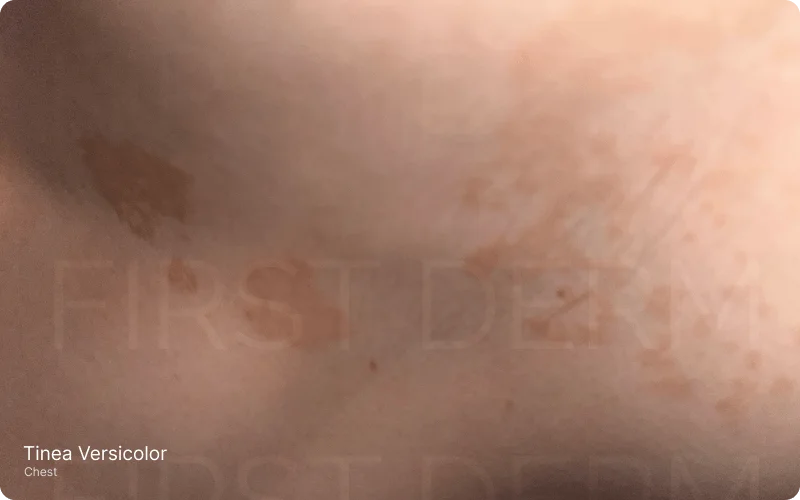
Close-up of pigmented, scaly patches on the chest, identified as Pityriasis Versicolor. This non-contagious skin condition is common in young people and is caused by an overgrowth of the Malassezia species fungus.
Tinea versicolor is a common fungal skin illness. The fungus disrupts the skin’s natural pigmentation, resulting in tiny, discolored spots. These patches, which are often found on the trunk and shoulders, can be brighter or darker in color than the surrounding skin.
Pityriasis alba
Close-up of the face featuring areas of decreased pigmentation, indicative of Pityriasis Alba. These patches and discolorations occur without itching and are often residual from mild eczema, becoming more visible with sun exposure.
Pityriasis alba is a prevalent skin ailment that affects children and young people between the ages of three and sixteen. It is distinguished by the appearance of ill-defined, scaly, erythematous patches.
Acne rosacea
Close-up of forehead showing small red spots and general redness, characteristic of Acne Rosacea. This inflammatory condition is common in adults over 30 and presents patches and discolorations without constant itch.
In rosacea you may get circular red lumps on your skin (papules) as well as pus-filled swellings (pustules). These patches, which resemble pimples, emerge on your face.
Experiencing Non-Itchy Skin Patches, Discolorations, or Raised Bumps?
Share your Symptoms & Images anonymously for a Private Evaluation. Consult with a specialist dermatologist and get the support you need.
Common Misconceptions About Non-Itchy Skin Conditions
Lichen Sclerosis: When Itchiness Isn’t a Symptom
Lichen sclerosis (LS) is a skin ailment that causes thin, whitish, and wrinkled skin, as well as itching and suffering. LS is most common in postmenopausal women, but men, children, and premenopausal women can also be affected.
Psoriasis: Scaling Without Scratching

Psoriasis Vulgaris on the scalp, highlighting the red, scaly plaques that are common symptoms of this chronic inflammatory skin condition. Note that despite the appearance, the condition is often not itchy.
The life cycle of your skin cells is dramatically accelerated in psoriasis, resulting in an accumulation of dead cells on the epidermis’s surface. Psoriasis is a skin condition that creates an itchy, scaly rash on the knees, elbows, trunk, and scalp.
Actinic Keratosis
Close-up view of Actinic Keratosis, a precancerous lesion commonly found on sun-damaged skin. Consult a dermatologist for appropriate diagnosis and treatment options
Risk factors include
- Have red or blond hair and blue or light-colored eyes.
- Have a history of a lot of sun exposure or sunburn.
- Tend to freckle or burn when exposed to sunlight.
- Are older than 40.
- Live in a sunny place
Skin cancer moles are the most serious sort of skin lesion. Normal moles are harmless and harmless. However, they always provide a concern: if a mole changes color, size, or shape, it can be problematic owing to the possibility of skin cancer. So anyone with a non-itchy rash should consult his/her doctor immediately.
References
[1] Smith L, Angarone MP. Sexually Transmitted Infections. Urol Clin North Am. 2015 Nov;42(4):507-18. https://pubmed.ncbi.nlm.nih.gov/26475947
[2]Wagenlehner FM, Brockmeyer NH, Discher T, Friese K, Wichelhaus TA. The Presentation, Diagnosis, and Treatment of Sexually Transmitted Infections. Dtsch Arztebl Int. 2016 Jan 11;113(1-02):11-22. https://www.ncbi.nlm.nih.gov/pmc/articles/PMC4746407/
[3]Gray R, Kigozi G, Kong X, Ssempiija V, Makumbi F, Wattya S, Serwadda D, Nalugoda F, Sewenkambo NK, Wawer MJ. The effectiveness of male circumcision for HIV prevention and effects on risk behaviors in a posttrial follow-up study. AIDS. 2012 Mar 13;26(5):609-15. https://www.ncbi.nlm.nih.gov/pmc/articles/PMC4296667/
[4]Farley TM, Samuelson J, Grabowski MK, Ameyan W, Gray RH, Baggaley R. Impact of male circumcision on risk of HIV infection in men in a changing epidemic context – systematic review and meta-analysis. J Int AIDS Soc. 2020 Jun;23(6):e25490. https://www.ncbi.nlm.nih.gov/pmc/articles/PMC7303540/
[5]Tripathi N, Mousa OY. StatPearls [Internet]. StatPearls Publishing; Treasure Island (FL): Jun 11, 2022. Hepatitis B. https://pubmed.ncbi.nlm.nih.gov/32310405
[6]Irizarry L, Velasquez J, Wray AA. StatPearls [Internet]. StatPearls Publishing; Treasure Island (FL): May 22, 2023. Chancroid. https://pubmed.ncbi.nlm.nih.gov/30020703
Ask a Dermatologist
Anonymous, fast and secure!

The Specialist doctor from the University Hospital in Gothenburg, alumnus UC Berkeley. My doctoral dissertation is about Digital Health and I have published 5 scientific articles in teledermatology and artificial intelligence and others.
